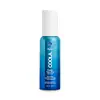What's inside
What's inside
 Key Ingredients
Key Ingredients

 Benefits
Benefits

 Concerns
Concerns

 Ingredients Side-by-side
Ingredients Side-by-side

Butyl Methoxydibenzoylmethane 3%
UV AbsorberHomosalate 10%
Skin ConditioningEthylhexyl Salicylate 5%
UV AbsorberOctocrylene 10%
UV AbsorberBenzophenone-3 5%
UV AbsorberAlcohol Denat.
AntimicrobialIsobutane
Propane
Isododecane
EmollientEthylhexyl Methoxycrylene
Skin ConditioningPvp
Emulsion StabilisingMethyl Dihydroabietate
Hydrolyzed Hyaluronic Acid
HumectantRhodiola Rosea Root Extract
EmollientWater
Skin ConditioningLavandula Angustifolia Oil
MaskingSilica Silylate
EmollientPentylene Glycol
Skin ConditioningButyl Methoxydibenzoylmethane 3%, Homosalate 10%, Ethylhexyl Salicylate 5%, Octocrylene 10%, Benzophenone-3 5%, Alcohol Denat., Isobutane, Propane, Isododecane, Ethylhexyl Methoxycrylene, Pvp, Methyl Dihydroabietate, Hydrolyzed Hyaluronic Acid, Rhodiola Rosea Root Extract, Water, Lavandula Angustifolia Oil, Silica Silylate, Pentylene Glycol
Butyl Methoxydibenzoylmethane 2.9%
UV AbsorberEthylhexyl Salicylate 4.9%
UV AbsorberOctocrylene 9.5%
UV AbsorberAlcohol
AntimicrobialButyloctyl Salicylate
Skin ConditioningEthylhexyl Methoxycrylene
Skin ConditioningPolyester-8
Skin ConditioningParfum
MaskingVa/Butyl Maleate/Isobornyl Acrylate Copolymer
Carthamus Tinctorius Seed Oil
MaskingRubus Idaeus Seed Oil
EmollientMauritia Flexuosa Fruit Oil
Skin ConditioningLimnanthes Alba Seed Oil
Skin ConditioningBrassica Campestris Seed Oil
Skin ConditioningCamellia Sinensis Leaf Extract
AntimicrobialGlycyrrhiza Glabra Root Extract
BleachingOpuntia Ficus-Indica Flower Extract
Skin ConditioningCamelina Sativa Seed Oil
Skin ConditioningBisabolol
MaskingGlycerin
HumectantWater
Skin ConditioningEthyl Ferulate
AntioxidantDiisooctyl Succinate
EmollientButyl Methoxydibenzoylmethane 2.9%, Ethylhexyl Salicylate 4.9%, Octocrylene 9.5%, Alcohol, Butyloctyl Salicylate, Ethylhexyl Methoxycrylene, Polyester-8, Parfum, Va/Butyl Maleate/Isobornyl Acrylate Copolymer, Carthamus Tinctorius Seed Oil, Rubus Idaeus Seed Oil, Mauritia Flexuosa Fruit Oil, Limnanthes Alba Seed Oil, Brassica Campestris Seed Oil, Camellia Sinensis Leaf Extract, Glycyrrhiza Glabra Root Extract, Opuntia Ficus-Indica Flower Extract, Camelina Sativa Seed Oil, Bisabolol, Glycerin, Water, Ethyl Ferulate, Diisooctyl Succinate
Ingredients Explained
These ingredients are found in both products.
Ingredients higher up in an ingredient list are typically present in a larger amount.
Also known as Avobenzone, this ingredient is a chemical sunscreen filter that provides protection in the UV-A range.
Avobenzone is globally approved and is the most commonly used UV-A filter in the world.
Studies have found that avobenzone becomes ineffective when exposed to UV light (it is not photostable; meaning that it breaks down in sunlight). Because of this, formulations that include avobenzone will usually contain stabilizers such as octocrylene.
However, some modern formulations (looking at you, EU!) are able to stabilize avobenzone by coating the molecules.
Avobenzone does not protect against the UV-B range, so it's important to check that the sunscreen you're using contains other UV filters that do!
The highest concentration of avobenzone permitted is 3% in the US, and 5% in the EU.
Learn more about Butyl MethoxydibenzoylmethaneThis ingredient is a photostabilizer and a chemical UV booster. It is marketed as an alternative to octocrylene.
You'll most likely find it in sunscreens to enhance stability and effectiveness of UV filters, antioxidants, and vitamin A derivatives. According to the manufacturer, this ingredient is better than octocrylene at stabilizing avobenzone.
Due to regulation loopholes, you'll likely see this ingredient in "100% mineral" sunscreens.
Learn more about Ethylhexyl MethoxycryleneEthylhexyl Salicylate is an organic compound used to block UV rays. It primarily absorbs UVB rays but offers a small amount of UVA protection as well.
Commonly found in sunscreens, Ethylhexyl Salicylate is created from salicylic acid and 2-ethylhexanol. You might know salicylic acid as the effective acne fighter ingredient and BHA.
The ethylhexanol in this ingredient is a fatty alcohol and helps hydrate your skin, similar to oils. It is an emollient, which means it traps moisture into the skin.
According to manufacturers, Ethylhexyl Salicylate absorbs UV wavelength of 295-315 nm, with a peak absorption at 307-310 nm. UVA rays are linked to long term skin damage, such as hyperpigmentation. UVB rays emit more energy and are capable of damaging our DNA. UVB rays cause sunburn.
Learn more about Ethylhexyl SalicylateOctocrylene protects skin from sun damage. It absorbs UV-B with peak absorption of 304 nm. It is a common sunscreen ingredient and often paired with avobenzone, a UVA filter. This is because octocrylene stabilizes other sunscreen ingredients by protecting them from degradation when exposed to sunlight. Octocrylene is a photostable ingredient and loses about 10% of SPF in 95 minutes.
Octocrylene also acts as an emollient, meaning it helps skin retain moisture and softens skin. It is oil-soluble and hydrophobic, enhancing water-resistant properties in a product.
Those who are using ketoprofen, a topical anti-inflammatory drug, may experience an allergic reaction when using octocrylene. It is best to speak with a healthcare professional about using sunscreens with octocrylene.
The EU allows a maximum of these concentrations:
Learn more about OctocryleneWater. It's the most common cosmetic ingredient of all. You'll usually see it at the top of ingredient lists, meaning that it makes up the largest part of the product.
So why is it so popular? Water most often acts as a solvent - this means that it helps dissolve other ingredients into the formulation.
You'll also recognize water as that liquid we all need to stay alive. If you see this, drink a glass of water. Stay hydrated!
Learn more about Water